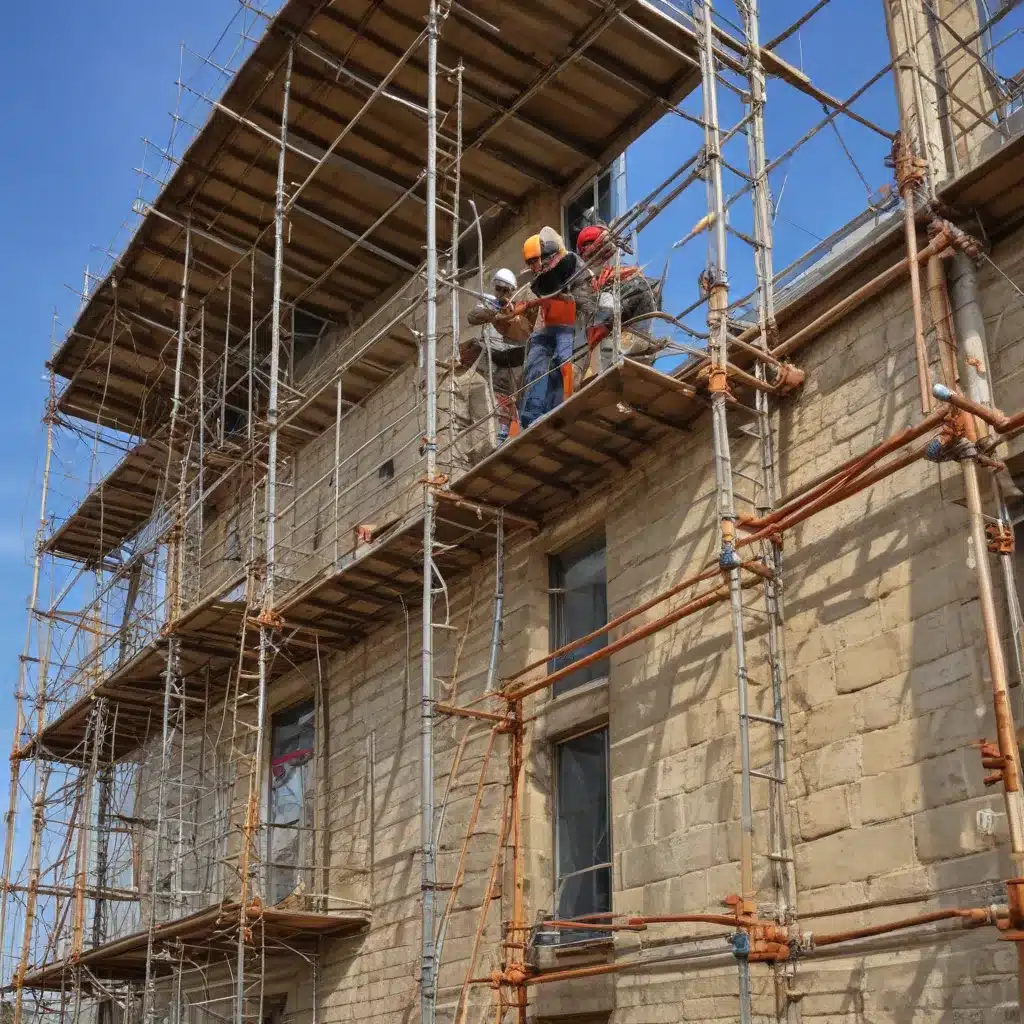
Navigating the Challenges of Slough’s Terrain: A Scaffolder’s Perspective
As a seasoned scaffolder in Slough, UK, I’ve seen my fair share of construction sites that would make even the bravest of builders quiver in their steel-toed boots. From rolling hills to unexpected dips and divots, the terrain in our neck of the woods can be a real nightmare to navigate. But fear not, my fellow scaffolding enthusiasts, for I’ve got a few tricks up my sleeve that can help you conquer even the most unforgiving of landscapes.
You see, when it comes to erecting scaffolding on sloping or uneven terrain, it’s not just a matter of slapping a few poles together and calling it a day. Oh, no, my friends. It’s a delicate dance, a carefully choreographed ballet of metal and precision that requires a keen eye, a steady hand, and a deep understanding of the science behind it all.
Tip 1: Level the Playing Field
Imagine you’re a tightrope walker, balancing precariously on a wire stretched between two skyscrapers. Now, picture that wire as being the foundation of your scaffolding, and the skyscrapers as the ground beneath your feet. If the ground isn’t level, it’s like trying to walk a tightrope that’s constantly shifting and swaying – a recipe for disaster, if you ask me.
That’s why the first and most crucial step in erecting scaffolding on uneven terrain is to ensure that the base is as level as can be. This might involve digging into the soil to create a flat surface, or using sturdy, adjustable base plates to compensate for any inclines or dips. Trust me, taking the time to get this right will save you a world of headache (and potential lawsuits) down the line.
Tip 2: Anchor Down
Now, once you’ve got your base sorted, it’s time to start building up. But here’s the thing – on sloping or uneven terrain, your scaffolding is going to be subject to some pretty intense forces. We’re talking about gravity, wind, and the sheer weight of the materials you’ll be using. If you don’t anchor that thing down properly, it’s going to be about as stable as a newborn giraffe on ice skates.
That’s why I always recommend using heavy-duty base plates and securing them to the ground with sturdy anchors. Think of it like staking a tent – you wouldn’t just plop it down on the grass and hope for the best, would you? Nope, you’d dig in those pegs and make sure that sucker isn’t going anywhere, no matter how hard the wind blows.
Tip 3: Distribute the Load
Alright, so you’ve got your base leveled and your scaffolding anchored down. Great, but we’re not done yet. You see, when you’re working on an uneven surface, the weight of the scaffolding isn’t going to be evenly distributed. Some parts of the structure are going to be bearing more of the load than others, and if you’re not careful, you could end up with a real-life version of the Leaning Tower of Pisa on your hands.
To prevent this, you’ll need to be strategic in how you distribute the weight of the scaffolding. This might involve using additional base plates or adjustable legs to ensure that the load is spread out evenly. It’s all about finding that perfect balance, like a tightrope walker navigating a high-wire act.
Tip 4: Brace for Impact
Now, let’s talk about the wind. If you’ve ever been on a construction site during a blustery day, you know just how much of a force it can be. And when you’re dealing with uneven terrain, that wind can wreak absolute havoc on your scaffolding.
That’s why it’s crucial to incorporate robust bracing into your design. Think of it like the scaffolding equivalent of a superhero’s cape – it’s what’s going to keep your structure from getting blown away by the elements. Whether it’s diagonal braces, cross-braces, or even some strategic guy-wires, make sure your scaffolding is ready to stand strong against the howling gales that Slough is known for.
Tip 5: Inspect and Maintain
Last but not least, remember that even the best-laid plans can go awry if you don’t keep a close eye on your scaffolding. Regularly inspecting your structure for signs of wear and tear, and performing any necessary maintenance, is crucial to ensuring the safety of your workers and the success of your project.
After all, scaffolding isn’t just a tool – it’s a living, breathing entity that’s constantly adapting to the ever-changing conditions of the jobsite. And when you’re working on sloping or uneven terrain, those adaptations become even more critical. So don’t be a stranger to your scaffolding – get up close and personal, and make sure it’s always in tip-top shape.
Conclusion: Embracing the Challenges of Slough’s Terrain
Now, I know what you’re thinking – “Whew, that’s a lot of work just to put up some scaffolding!” But trust me, my friends, the effort is well worth it. When you conquer the challenges of Slough’s terrain, you’re not just erecting a structure – you’re making a statement. You’re saying, “Hey, Mother Nature, bring it on! I’ve got the skills and the know-how to tackle even your most treacherous landscapes.”
And who knows, maybe you’ll even inspire the next generation of scaffolders to reach new heights (pun intended) and push the boundaries of what’s possible. Because when it comes to our industry, the only limit is your imagination – and your ability to keep that scaffolding standing tall, no matter what the ground beneath it has in store.
So, are you ready to take on the slopes and valleys of Slough? Then grab your tools, your hard hat, and your best problem-solving skills, and let’s get to work. The future of scaffolding is ours for the taking!


